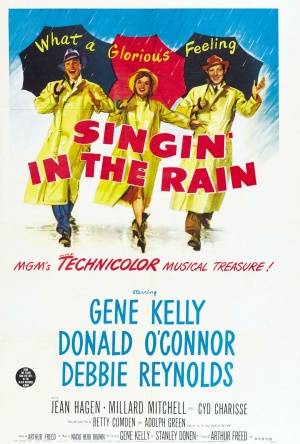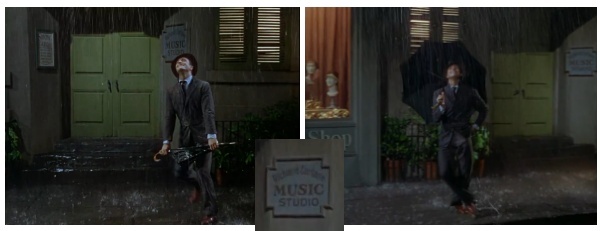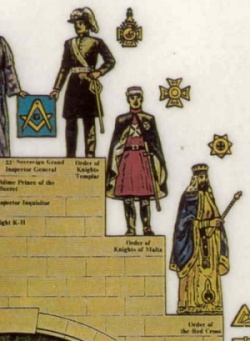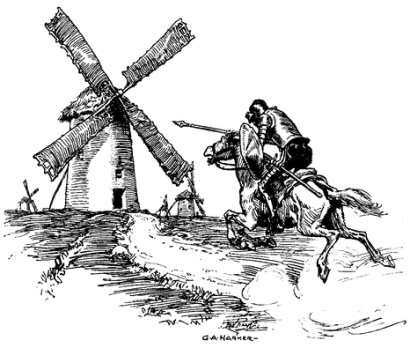
This classic film is recognized as a standard in the industry, and probably not just for song and dance. There's an impressive range of subtle sodomite gateway symbols woven in very cleverly with Freemasonry imagery. What we see in this clip spills the beans on Illuminati activity in your neighborhood and mine, on MK-ULTRA, Monarch or SRA programming. The reason we haven't recognized the activity is because it's done in secret. The reason we haven't recognized the signs of it that are set right out in plain sight is because we've been programmed not to see it. The cloaking is a spiritual matter, but the supernaturalism is contingent upon the symbols through which the demonic power is projected. These symbols through which their secret ways and means are expressed are the tangible evidence of the hidden activity.
I had left off describing how the Singin' in the Rain sequence ends with an exhibit of how the protective seal on the programmers activity is ultimately maintained, with the policeman in front of the Art School demonstrating how the authorities are complicit. In this post, we're going to examine the complement to that scene, which provides exceptional insight into how the programmers get away with it through views of the agents and mechanisms at work, including those in vehicles like this film.
If you use two monitors, you may find it helpful to open the video in one while you read this post in the other.
 "Singin' in the Rain" 1952 ~ Gene Kelly
"Singin' in the Rain" 1952 ~ Gene Kelly
If you're a victim of ritual abuse who is still being delivered or you're easily offended by mature subjects and descriptive language, please move on. If you're new to this series, welcome! You may want to start at the beginning to get the foundation for what's here.
Series Links: The Sodomite Gateway
At the 2:44 minutes mark, Don leaves the Egyptian sex magick set at the Pharmacy. He passes a rather plain setting on his way over to the umbrella programming scene staged at the LaValle Millinery Shop. After some very effeminate prancing in front of this rather dull setting, which the sign says is the Richard Carlane Music Studio, he arrives at the programming set, where the millinery shop and the bookstore are distinctly linked together, as I described in Part 96. What happens there requires the highest level of security. After looping around the millinery shop and bookstore, Don arrives at the Mount Hollywood Art School, where he splashes around in the puddles and encounters the policeman. As a last line of defense in their security scheme, we have the policeman, in front of the Art School. At the other end is its complement, where other kinds of security are on exhibit in front of the Music Studio. (Music and Arts - keep that in mind.)

There's plenty of what might be considered as rather generic sodomite sex magick being modeled by Don's routine (who's being particularly "light on his feet," don't you think?), but I perceive three distinct kinds of symbols that suggest that the security theme is the reason for the set, which really must be seen as validation of the reason for the symmetry. To really cap it off, there's another layer of symbolism that links two of those kinds of symbols together! Yes, it is complex. That's the nature of their business.
Note the two pairs of louvered shutters at the Studio. These are storm shutters, sure, but they are also functioning as blinds. They filter the light, they control the view through the window. Aliester Crowley used language that included this terminology. This famous Freemason, Theosophist and illuminated sorcerer, who relished being labeled "the worlds most wicked man," wrote the following in "The Book of Lies." "
The card 15 in the Tarot is "The Devil", the mediaeval blind for Pan." He was declaring his understanding of how the Devil is actually Pan, and his use of "blind" is akin to how we might use the word "code." "The Devil is code for Pan." It's a substitute used for obfuscation and deception. In the same book, his use of the plural clarifies the word further. "
Paragraph 1 is, of course, a well-known scientific fact. In paragraph 2 it is suggested analogically that all thinkable things are similarly blinds for the Unthinkable Reality." The blind is a symbol, representing something else. It provides a layer of secrecy, guarding the sensitive reality.

I've noted a few times in this blog how blinds are featured as graphical elements in some logos, ads, commercials and such to signal that an Occult work is present but concealed. That's the case at the Music Studio, where the louvered shutters conceal and reveal the light filtering through the windows as an allegory. This is one of the three kinds of security elements.
Another kind are the crosses. A couple of instances are signaled as Don crosses his legs while dancing. The most obvious instance of the cross appears on the entry doors, a
plus sign sodomite symbol. Putting this on the doors is perfectly fitting for the signal anus of the sodomite gateway. Such a cross is usually red, or white on red, because it signifies the crossing of the blood streams and life force of the two engaged in ritual sodomy. It signifies the binding function of that act, and the blood oath not to tell about it. It represents the protection afforded a member by that fraternity of the blood oath. Another instance appears in the stylized shape of the Studio sign. It's subtle, but it's the shape of the emblem of the York Rite Order of Knights Templar, the top level order that equates to the 33rd degree of Scottish Rite Freemasonry! It's a
sign, get it? Ignore the words and read the shape.

The top three levels of the steps of York Rite Freemasonry have the cross shape featured in their symbolism. With that observation, you can identify this scene as yet one more Masonic setting. The front of the Music Studio has the three steps, and this ascending entryway is like a step pyramid that resembles the diagram of the Steps of Freemasonry. To the right is what looks like a close match to the form of the cross of the Knights Templar.
The place is probably named the Richard Carlane Music Studio to make allusion to the Ancient Mystical Order Rosae Crucis, the Rosicrucians. ( Richard Carlane ~ RC ~ Rosy Cross ~ Rosae Crucis ~ Christian Rosenkreuz ~ Roman Catholic)
They're BIG on Egyptian artifacts and esoteric symbols.
The sodomite fraternity that appears to be most particularly identified by the RC sign is infamous for providing the kind of defence and security that assures the continuation of their work and the status quo of the illumined elite. The Knights of Malta. Heads UP!

If you choose to research them very deeply, be prepared to engage in spiritual warfare. And, to that I must add alongside them the Knights of Columbus. KC~K=11 C=3 ~ KC=33
So, the shutters signal Crowley's blind, the way of coding language to guard the sensitive realities, a way of obfuscation. The crosses signal the binding sodomite oaths to secrecy and the protection afforded by the Illuminati brotherhood. The third kind of symbol implying that security is the reason for the set is the fencing. The fencing is subtle, but our attention is drawn to it when Don draws his umbrella across the fence posts to make a little music. You know what a fence is, right? Here's a few definitions.
- A structure serving as an enclosure, a barrier, or a boundary
- Archaic - A means of defense; a protection
- To avoid giving direct answers; hedge
Now, when you put the matter of the fencing together with the crosses and shutters, this becomes quite the showcase of defensive mechanisms! I had referred to Don's prancing around in front of the Music Studio as rather generic sodomite sex magick, but the choreography brilliantly layers in some elements that connect these things together in a vivid way!

One of Don's charades involves the kind of fencing that is a classic European martial art, where he wields the umbrella as a kind of sword. Following this fencing demonstration, Don runs his umbrella-sword across the fence posts to make the connection for us. When we identify the umbrella as a sword we recognize that link to the fence and one to the knights identified by the cross symbol. On the Steps of Freemasonry you can see swords at the side of the Knight Templar and Knight of Malta, dressed in their military regalia. The martial art of fencing an example of the many skills used in the defense of their realm.
The identification Don makes with the Knights is even much stronger yet when you identify the umbrella as a medieval lance! His prancing presents him as the lance wielding knight, riding a prancing horse. As he dances in this scene, the tap dancing sound provides the soundtrack of the horse's hooves. And, here's the seal on the deal. When he makes his first pass across the set, he's windmilling the umbrella, spinning it around like a windmill.
This Don is Don Quixote! The reason for choreographing this epic character, who had an obsession with chivalric literature, spoke in the Old Castilian language and wore old armor that probably derived from the grail quest period, has to be the link to the knights of the sodomite cross, the Illuminati security force.

Today, Don Quixote seems rather obscure, but the novel's windmill scene would have been more recognizable in 1952. That literary work is widely accepted as a masterpiece. According to Wikipedia, "
As a founding work of modern Western literature, and one of the earliest canonical novels, it regularly appears high on lists of the greatest works of fiction ever published. In a 2002 list, Don Quixote was cited as the "best literary work ever written"." In 1959, a teleplay based on the book came out, and that was adapted into a musical called "Man of LaMancha," which has become one of the most enduring works of musical theater. The song, "The Impossible Dream" came from that musical.
I'm not sure I would have recognized the reference to Don Quixote if I had not seen a cryptic reference to the novel while studying one of the Fringe episodes that featured the black umbrella. That's a post I'm really looking forward to!
There's plenty of protection being signaled here to balance the policeman at the other end of the programming scene. What this Singin' in the Rain musical is concealing and revealing is just how it is that the programming and programmers are very well protected.
There's more here, even in this scene, but I'm going to leave it for another post, Lord willing!

No comments:
Post a Comment